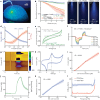This is a preprint.
Fiber-based Probes for Electrophysiology, Photometry, Optical and Electrical Stimulation, Drug Delivery, and Fast-Scan Cyclic Voltammetry In Vivo
- PMID: 38895451
- PMCID: PMC11185794
- DOI: 10.1101/2024.06.07.598004
Fiber-based Probes for Electrophysiology, Photometry, Optical and Electrical Stimulation, Drug Delivery, and Fast-Scan Cyclic Voltammetry In Vivo
Abstract
Recording and modulation of neuronal activity enables the study of brain function in health and disease. While translational neuroscience relies on electrical recording and modulation techniques, mechanistic studies in rodent models leverage genetic precision of optical methods, such as optogenetics and imaging of fluorescent indicators. In addition to electrical signal transduction, neurons produce and receive diverse chemical signals which motivate tools to probe and modulate neurochemistry. Although the past decade has delivered a wealth of technologies for electrophysiology, optogenetics, chemical sensing, and optical recording, combining these modalities within a single platform remains challenging. This work leverages materials selection and convergence fiber drawing to permit neural recording, electrical stimulation, optogenetics, fiber photometry, drug and gene delivery, and voltammetric recording of neurotransmitters within individual fibers. Composed of polymers and non-magnetic carbon-based conductors, these fibers are compatible with magnetic resonance imaging, enabling concurrent stimulation and whole-brain monitoring. Their utility is demonstrated in studies of the mesolimbic reward pathway by simultaneously interfacing with the ventral tegmental area and nucleus accumbens in mice and characterizing the neurophysiological effects of a stimulant drug. This study highlights the potential of these fibers to probe electrical, optical, and chemical signaling across multiple brain regions in both mechanistic and translational studies.
Keywords: FSCV; fiber-based interface; fiber-photometry; multifunctional neural probe; neuromodulation.
Conflict of interest statement
Conflict of Interest N.D., M.-J. A. and P.A. are co-founders and have a financial interest in NeuroBionics Inc.
Figures




Similar articles
-
Multifunctional Neural Probes Enable Bidirectional Electrical, Optical, and Chemical Recording and Stimulation In Vivo.Adv Mater. 2024 Nov 6:e2408154. doi: 10.1002/adma.202408154. Online ahead of print. Adv Mater. 2024. PMID: 39506430
-
Multifunctional Fibers as Tools for Neuroscience and Neuroengineering.Acc Chem Res. 2018 Apr 17;51(4):829-838. doi: 10.1021/acs.accounts.7b00558. Epub 2018 Mar 21. Acc Chem Res. 2018. PMID: 29561583 Review.
-
Multifunctional and Flexible Neural Probe with Thermally Drawn Fibers for Bidirectional Synaptic Probing in the Brain.ACS Nano. 2024 May 21;18(20):13277-13285. doi: 10.1021/acsnano.4c02578. Epub 2024 May 10. ACS Nano. 2024. PMID: 38728175 Free PMC article.
-
Multifunctional fibers for simultaneous optical, electrical and chemical interrogation of neural circuits in vivo.Nat Biotechnol. 2015 Mar;33(3):277-84. doi: 10.1038/nbt.3093. Epub 2015 Jan 19. Nat Biotechnol. 2015. PMID: 25599177
-
Flexible fiber-based optoelectronics for neural interfaces.Chem Soc Rev. 2019 Mar 18;48(6):1826-1852. doi: 10.1039/c8cs00710a. Chem Soc Rev. 2019. PMID: 30815657 Review.
References
Publication types
Grants and funding
LinkOut - more resources
Full Text Sources
Miscellaneous
